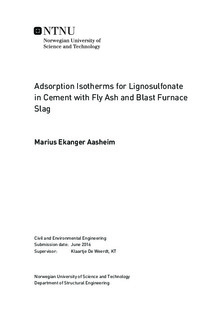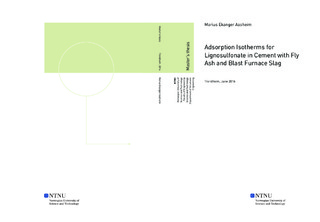| dc.description.abstract | Plasticizers are used to increase the workability of cement in its fresh state. When adding plasticizers to a paste, the molecules chemically adsorb on the surface of cement particles. This interaction between the plasticizer and binders is complex and depends on several parameters, including cement type, addition of mineral admixtures and method of addition.
In this study the adsorption of lignosulfonate, a well-known superplasticizer, on binders is investigated. Different binders are thought to affect adsorption differently, so adsorption is tested on cements with and without fly ash and ground granulated blast furnace slag. The goal is to better understand the effects of different binders on the adsorption of lignosulfonate through evaluation of adsorption isotherms obtained experimentally.
Paste samples with a w/b-ratio of 0.4 by volume with different binders are tested for lignosulfonate adsorption using UV-spectroscopy analysis. Two cements (ANL and CX) with and without the addition of fly ash and ground granulated blast furnace slag in replacement levels 30% and 60% were used. The lignosulfonate consumption is tested both for immediate addition with water and 10 minutes delayed addition to a fresh paste; the concentrations ranged from 0.05 to 1.5 g lignosulfonate / 100 g binders. Adsorption isotherms are then determined and compared to evaluate the contribution from the mineral admixtures. To investigate the correlation between the pH and consumption, pH measurements were performed on the pastes.
The consumption on blended cements with fly ash and ground granulated blast furnace slag in this study are shown to have the same consumption behavior as neat cements. There are some differences between the different binders, but the standard deviations obtained is larger than the impact of these mineral admixtures, making it hard to conclude any significance from them. The cements also have small, though significant differences in lignosulfonate adsorption. ANL seems to adsorb more than CX, especially for higher concentrations of lignosulfonate. The most apparent difference is a result of addition method: the immediate addition of lignosulfonate together with water more than doubles the amount adsorbed compared to 10 minutes delayed addition after wetting for many samples. Immediate addition shows a linear form in the adsorption isotherms, while delayed addition for most part can be described with the Langmuir model. There is also no apparent correlation between pH and adsorption of lignosulfonate.
It is therefore clear from the experimental results that the addition of fly ash or ground granulated blast furnace slag neither increases or decreases the consumption significantly compared to neat cements. Although the materials are different, they seem to behave similarly in lignosulfonate consumption. Other parameters, such as addition time, have a far more significant effect. | |

